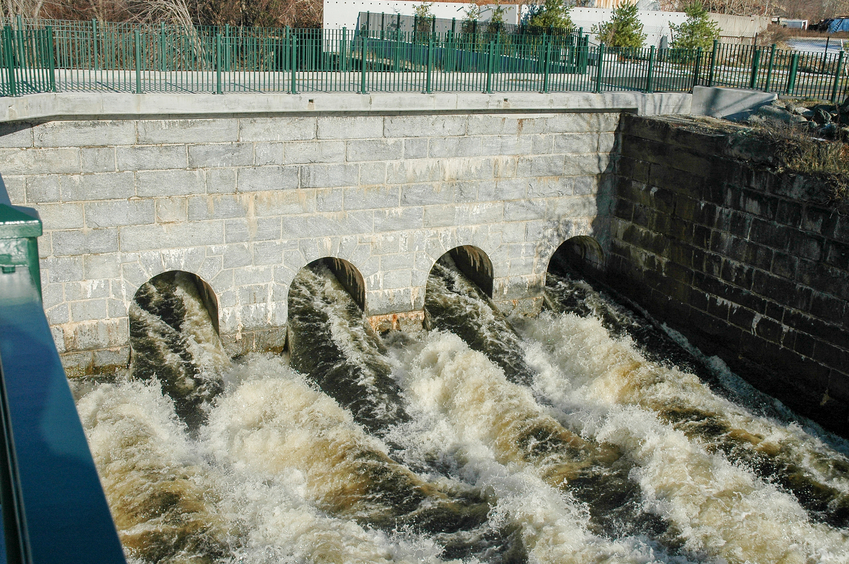Ontario Structural 15 PDH Discount Package 2
Building a Storm-Resistant Safe Room (F04-005)
Protecting Homes from High Wind Damage (S02-017)
Tunnel Operations, Maintenance, Inspection, and Evaluation Manual: Evaluation (C02-073)
Tunnel Operations, Maintenance, Inspection, and Evaluation Manual: Maintenance (C02-074)
Tunnel Operations, Maintenance, Inspection, and Evaluation Manual: Operations (C01-019)

This online engineering PDH course provides guidance on the design and construction of conduits, culverts, and pipes, as well as design procedures for trench/embankment earth loadings, highway loadings, railroad loadings, surface concentrated loadings, and internal/external fluid pressures.
In general, reinforced concrete conduits, culverts and pipes are used for dams, urban levees, and other levees where public safety is at risk or substantial property damage could occur. Corrugated metal pipes are acceptable through agricultural levees where conduits are 900-mm (36-in.) diameter and where levee embankments are not higher than 4 m (12 ft) above the conduit invert. Inlet structures, intake towers, gate wells, and outlet structures are usually concrete. However, corrugated metal structures may be used in agricultural and rural levees.
This 4 PDH online course is applicable to civil, structural and geotechnical engineers, as well as design and construction personnel involved with the design and installation of conduits, culverts and pipes.
This P.Eng. continuing education course is intended to provide you with the following specific knowledge and skills:
- Design and installation of cast-in-place conduits for dams
- Design and installation of circular reinforced concrete pipe for small dams and levees
- Design and installation of corrugated metal pipe for rural levees and culverts
- Design and installation of concrete culverts
- Design and installation of plastic pipe for other applications
- Design and installation of ductile iron and steel pipe for other applications
- Design and construction guidelines for pipe jacking
In this professional engineering CEU course, you need to review the US Corps of Engineers Publication EM 1110-2-2902, "Conduits, Culverts and Pipes".
Upon successful completion of the quiz, print your Certificate of Completion instantly. (Note: if you are paying by check or money order, you will be able to print it after we receive your payment.) For your convenience, we will also email it to you. Please note that you can log in to your account at any time to access and print your Certificate of Completion.

This online engineering PDH course covers the design and construction of storm-resistant safe rooms that provide near-absolute protection from tornado or hurricane winds and associated flying debris. The designs considered are applicable to homes, small businesses, and small community shelters.
Every year, tornadoes, hurricanes, and other extreme windstorms injure and kill people, and cause millions of dollars of property damage in the United States. Even so, more and more people build homes in tornado and hurricane-prone areas, possibly putting themselves in the path of such storms.
This 3 PDH online course is particularly applicable to engineers in government agencies and the military concerned with construction practices and to engineers in the construction industry.
This P.Eng. continuing education course is intended to provide you with the following specific knowledge and skills:
- Procedures for assessing risk and determining if building a safe room is appropriate
- Alternative safe-room locations such as underneath, in the basement, or in an interior room of a new home or small business
- Effects of type of foundation on safe-room design
- Design guidance on how to add a safe room to an existing structure
- Selection of appropriate construction materials
- Safe-room designs for homes or small businesses that meet or exceed the minimum shelter design requirements from the ICC-500 Storm Shelter Standard
- Cost estimating for safe-room construction
In this professional engineering CEU course, you need to review the publication: Taking shelter from the Storm, Building a Safe Room for Your Home or Small Business, FEMA P-320, Fourth Edition, December 2014.
Once you complete your course review, you need to take a multiple-choice quiz consisting of twenty (20) questions to earn 4 PDH credits. The quiz will be based on this FEMA publication.
Upon successful completion of the quiz, print your Certificate of Completion instantly. (Note: if you are paying by check or money order, you will be able to print it after we receive your payment.) For your convenience, we will also email it to you. Please note that you can log in to your account at any time to access and print your Certificate of Completion.

This online engineering PDH course will introduce you to the principles and practices of protecting residential structures from high winds. This course demonstrates that some seemingly minor areas of weakness could provide a path for high winds to enter the home and cause serious damage. The course presents remedies for the most common weaknesses and the highest priority preparations for high winds.
A team of experts examined homes that had failed and homes that had survived damage from Hurricane Andrew. It has been found that once high winds penetrate the building envelope (outer shell) of the home, the likelihood of significant structural damage to the home greatly increases. The team of experts identified common areas that should be checked for weakness: roof, doors, windows, garage doors (where applicable), roofing systems, and external insulating finishing systems (EIFS). Gable roof systems were also found to be more likely to suffer damage during a high wind event. Each area of weakness identified in this course also includes simple and effective remedies which increase the chances of a home surviving the storm with less damage.
This 2 PDH online course is intended for engineers, architects, contractors, and homeowners who are interested in gaining an understanding of the benefits of proper preparation for high winds. Additionally, this course could be useful as a guide for implementing a storm preparation plan or a maintenance plan.
This P.Eng. continuing education course is intended to provide you with the following specific knowledge and skills:
- Awareness that protecting the home does not decrease the urgency to evacuate
- Understanding the importance of protecting the building envelope
- Learning the common areas of weakness in residential structures during high wind storms
- Learning about the remedies for the common areas of weakness in a structure
- Learning how to prepare the home for high winds
- Learning how to prepare the property around the home for high winds
- Realizing the role of regular home inspections in reinforcing homes against high winds
- Realiziing the role of routine home maintenance in reinforcing homes against high winds
In this professional engineering CEU course you will need to review the FEMA Publication titled, "Protecting Your Home from Hurricane Wind Damage" which is based on a compilation of several FEMA articles.
Upon successful completion of the quiz, print your Certificate of Completion instantly. (Note: if you are paying by check or money order, you will be able to print it after we receive your payment.) For your convenience, we will also email it to you. Please note that you can log in to your account at any time to access and print your Certificate of Completion.

This engineering online PDH course will provide an overview on the evaluation of tunnel systems and the associated components. The components explored in this chapter include the typical personnel involved, supplemental inspection and testing methods, risk-based assessments, priority classification, and basic cost estimating. Information is also provided on load rating.
Evaluations are normally performed after the inspection data is received. Sound engineering judgment is used to evaluate the consequences of tunnel system or component failure in terms of overall safety, service level, and costs. In some instances, supplementary inspections and testing may be needed where data is lacking. Risk assessment techniques should include strategies for deploying, operating, maintaining, upgrading, and disposing of tunnel system components in a cost-effective manner.
This 2 PDH online course is applicable to civil and structural engineers, as well as design and construction personnel involved with the evaluation process of tunnel systems.
This P.Eng. continuing education course is intended to provide you with the following specific knowledge and skills:
- Understanding the evaluation criteria and methods of tunnel systems
- Identifying the typical personnel involved in tunnel evaluation procedures
- Familiarization with different testing methods
- Understanding risk-based assessments
- Recognizing priority classification
- Understanding the basics of cost estimating
Upon successful completion of the quiz, print your Certificate of Completion instantly. (Note: if you are paying by check or money order, you will be able to print it after we receive your payment.) For your convenience, we will also email it to you. Please note that you can log in to your account at any time to access and print your Certificate of Completion.

This engineering online PDH course will provide an overview on effective maintenance considerations of tunnel systems and the associated components.
An effective maintenance program helps reduce costs, decrease the number of tunnel closures, increase public safety, and ensure adequate levels of service. To maximize efficient use of resources and minimize costs, maintenance programs should be optimized. When large-scale repairs and upgrades are implemented, these projects are typically referred to as tunnel rehabilitation.
This 2 PDH online course is applicable to civil and structural engineers, as well as design and construction personnel involved with the maintenance process of tunnel systems.
This P.Eng. continuing education course is intended to provide you with the following specific knowledge and skills:
- Understanding the fundamental causes of deterioration and corrosion in tunnels.
- Familiarization with the methods aimed at controlling groundwater seepage.
- Familiarization with the repair techniques and rehabilitation schemes.
Upon successful completion of the quiz, print your Certificate of Completion instantly. (Note: if you are paying by check or money order, you will be able to print it after we receive your payment.) For your convenience, we will also email it to you. Please note that you can log in to your account at any time to access and print your Certificate of Completion.

This online engineering PDH course presents essential roles and responsibilities of the tunnel staff, normal operating procedures, and emergency response guidelines for vehicle collisions, fires, explosions, floods and earthquakes.
Operating requirements vary among tunnel facilities because of the traffic level, the feasibility of alternative routes, accessibility to existing utilities, availability of emergency responders, and other conditions specific to each tunnel. Functional systems within the tunnel must be integrated with operational procedures to include the mechanical equipment, electrical components, lighting fixtures, fire and life safety systems, signs and security equipment installed within the tunnel.
This 1 PDH online course is applicable to civil and structural engineers, as well as design personnel and staff involved in the operation of tunnel systems.
This P.Eng. continuing education course is intended to provide you with the following specific knowledge and skills:
- Understanding the essential roles and responsibilities of the tunnel staff
- Familiarization with normal tunnel operating procedures
- Understanding the emergency response guidelines for vehicle collisions, fires, explosions, floods, and earthquakes
Upon successful completion of the quiz, print your Certificate of Completion instantly. (Note: if you are paying by check or money order, you will be able to print it after we receive your payment.) For your convenience, we will also email it to you. Please note that you can log in to your account at any time to access and print your Certificate of Completion.